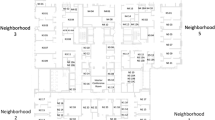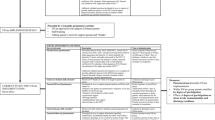Abstract
Objective:
Neonatal intensive care units (NICUs) impose stressors on development. Comparative studies have focused mostly on the units’ medical qualities and less on their developmental ‘ecology’. The aim of the study was to develop a tool for measuring the various domains of a developmentally appropriate practice in the NICU environment, and to assess its implementation in Israel.
Study Design:
A questionnaire, designed for NICU senior staff members, was completed by 76 respondents representing 24 NICUs in Israel. The tool that measures developmentally appropriate practice as applied in the NICU environment includes the following three domains: (a) parental and family involvement, (b) environmental control and (c) individualized care and assessment. These measures jointly produce the developmentally appropriate neonatal intensive-care practice (DANIP) index.
Result:
High variability was found in the application of procedures and programs considered developmentally appropriate. Units with a relatively large multidisciplinary team scored high. Overall, the NICUs in Israel did not consistently follow an integrated form of the developmental care as provided by the Neonatal Individualized Developmental Care and Assessment Program. It was found that individualized care and assessment was significantly and positively linked to control of the environment (r=0.53, P<0.01) and to parental and family involvement (r=0.76, P<0.01); the latter two scales were not associated. Of the three DANIP domains, parental involvement was salient. Although the staff highly appreciated the importance of environmental control and individualized care, application was limited.
Conclusion:
The DANIP index provides a good starting point for comparative studies.
This is a preview of subscription content, access via your institution
Access options
Subscribe to this journal
Receive 12 print issues and online access
$259.00 per year
only $21.58 per issue
Buy this article
- Purchase on Springer Link
- Instant access to full article PDF
Prices may be subject to local taxes which are calculated during checkout

Similar content being viewed by others
References
Als H . Earliest intervention for preterm infants in the newborn intensive care unit. In: Guralnick MJ (eds). The Effectiveness of Early Intervention. Paul H Brooks: Baltimore, 1997, pp 47–76.
Blackburn S . Environmental impact of the NICU on developmental outcomes. J Pediatr Nurs 1998; 1: 279–288.
Anand KJ . International evidence-based group for neonatal pain consensus statement for the prevention and management of pain in the newborn. Arch Pediatr Adolesc Med 2001; 155: 173–180.
Perlman JM . Neurobehavioral deficits in premature graduates of intensive care—potential medical and neonatal environmental risk factors. Pediatrics 2001; 108: 1339–1348.
Wolke D . Premature babies and the special care baby unit (SCBU)/neonatal intensive care unit (NICU): environmental, medical and developmental considerations. In: Niven CA, Walker A (eds). Current Issues in Infancy and Parenthood. Butterworth-Heinemann: Oxford, 1998, pp 255–273.
Sizun J, Westrup B, The ESF Network Coordination Committee. Early developmental care for preterm neonates: a call for more research. Archs Dis Child Fetal Neonatal Ed 2004; 89: 84–88.
Shepherd JT, Hanshaw JK, Lane SL . Working in the neonatal intensive care unit. In: Porr SM, Rainville EP (eds). Pediatric Therapy: a Systems Approach. FA Davis: Philadelphia, 1999, pp 313–369.
Gardner SL, Goldson E . The neonate and the environment: impact on development. In: Merenstein GB, Gardner SL (eds). Handbook of Neonatal Intensive Care. Mosby: St Louis, MO, 2002, pp 219–282.
Symington A, Pinelli J . Developmental care for promoting development and preventing morbidity in preterm infants. The Cochrane Database Syst Rev 2003; 4: CD0001814.
Blackburn S, VandenBerg K . Assessment and management of neonatal neurobehavioral development In: Kenner C, Gunderson LP, Brueggemeyer A (eds). Comprehensive Neonatal Nursing Care: a Physiologic Perspective. WB Saunders: Philadelphia, 1993; 1094–1133.
Evans JC . Comparison of two NICU patterns of caregiving over 24-hours for preterm infants. Neonatal Netw 1994; 13: 87.
Hunter JG . Neonatal intensive care unit. In: Case-Smith J (ed). Occupational Therapy for Children. Mosby: St Louis, MO, 2001; 636–708.
Als H, Lawhon G, Brown E, Gibes R, Duffy FH, McAnulty G et al. Individualized behavioral and environmental care for the very low birth weight preterm infant at high risk for bronchopulmonary dysplasia: neonatal intensive care unit and developmental outcome. Pediatrics 1986; 78: 1123–1132.
Als H, Lawhon G, Duffy FH, McAnulty GB, Gibes-Grossman R, Blickman JG . Individualized developmental care for the very low-birth-weight preterm infant: medical and neurofunctional effects. JAMA 1994; 272: 853–858.
Westrup B, Kleberg A, von Eichwald K, Stjernqvist K, Lagercrantz H . A randomized, controlled trial to evaluate the effects of the newborn individualized developmental care and assessment program in a Swedish setting. Pediatrics 2000; 105: 66–72.
Fleisher B, VandenBerg K, Costantenou J, Heller C, Benitz WE, Johnson A et al. Individualized developmental care for very low birth weight premature infants. Clin Pediatr 1995; 34: 523–529.
Resnick MB, Armstrong S, Carter RL . Developmental intervention program for high-risk premature infants: effects on development and parent–infant interactions. J Dev Behav Pediatr 1988; 9: 73–78.
Als H, Duffy FH, McAnulty GB, Rivkin MJ, Vajapeyam S, Mulkern RV et al. Early experience alters brain function and structure. Pediatrics 2004; 113: 846–858.
Jacobs SE, Sokol J, Ohlsson A . The newborn individualized developmental care and assessment program is not supported by meta-analyses of the data. Pediatrics 2002; 140: 699–706.
Petryshen P, Stevens B, Hawkins J, Stewart M . Comparing nursing costs for preterm infants receiving conventional vs developmental care. Nurs Econ 1997; 15: 138–145.
Ashbaugh JB, Leick-Rude MK, Kilbride HW . Developmental care teams in the neonatal intensive care unit: survey on current status. J Perinatol 1999; 19: 48–52.
Wallin L, Bostrom AM, Harvey G, Wikblad K, Ewald U . National guidelines for Swedish neonatal nursing care: evaluation of clinical application. Int J Qual Health Care 2000; 12: 465–474.
Robison LD . An organizational guide for an effective developmental program in the NICU. J Obstet Gynecol Neonatal Nurs 2003; 32: 379–386.
Hack M, Horbar JD, Malloy MH, Tyson KJ, Wright E, Wright L . Very low birth weight outcomes of the National Institute of Child Health and Human Development Neonatal Network. Pediatrics 1991; 87: 587–597.
Lee SK, McMillan DD, Ohlsson A, Pendray M, Synnes A, Whyte R et al. Variations in practice and outcomes in the Canadian NICU Network: 1996–1997. Pediatrics 2000; 106: 1070–1079.
Voht B, Wright LL, Dusick AM, Perritt R, Poole WK, Tyson JE et al. Center differences and outcomes of extremely low birth weight. Pediatrics 2004; 113: 781–790.
Bakewell-Sachs S, Blackburn S . State of the science: achievements and challenges across the spectrum of preterm infants. J Obstet Gynecol Neonatal Nurs 2003; 32: 683–695.
Rivkees SA, Mayes L, Jacobs H, Groos I . Rest-activity patterns of premature infants are regulated by cycled lighting. Pediatrics 2004; 13: 833–840.
O’Brien M, Dale D . Family-centered services in the neonatal intensive care unit: a review of research. J Early Intervention 1994; 18: 79–90.
Gale G, Franck LS . Toward a standard of care for parents of infants in the neonatal intensive care unit. Crit Care Nurse 1998; 18: 62–73.
Fernandez CV, Rees EP . Management in Canadian level 3 neonatal intensive care units. CMAJ 1994; 150: 499–504.
Rohrmeister K, Kretzer V, Berger A, Haiden N, Kohlhauser C, Pollak A . Pain and stress management in the neonatal intensive care unit: a national survey in Austria. Wien Klin Wochenschr 2003; 31: 715–719.
Siegel R, Gardner SL, Merenstein GB . In crisis: theoretic and practical considerations. In: Merenstein GB, Gardner SL (eds). Handbook of Neonatal Intensive Care. Mosby: St Louis, MO, 2002, pp 725–753.
Frank A, Maurer P, Shepherd J . Survey results on the light and sound in newborn intensive care units. Phys Occup Ther Pediatr 1991; 11: 27–45.
Westrup B, Stjernqvist K, Kleberg A, Hellstrom-Westas, Lagercrantz H . Neonatal individualized care in practice: a Swedish experience. Semin Neonatol 2002; 7: 447–457.
Harrison H . The principles for family centered neonatal care. Pediatrics 1993; 92: 643–650.
Minde K . Prematurity and serious medical conditions in infancy: implications for development, behavior and intervention. In: Charles H, Zeanah JR (eds). Handbook of Infant Mental Health. Guilford Press: New York, London, 2000; 176–194.
Heermann JA, Wilson ME, Wilhelm PA . Mothers in the NICU: outsider to partner. Pediatr Nurs 2005; 31: 176–200.
Sheikh L, O’Brien M, McCluskey-Fawcett K . Parent preparation for the NICU-to-home transition: staff and parent perceptions. Child Health Care 1993; 2: 227–239.
Johnson AN . Adapting the neonatal intensive care environment to decrease noise. J Perinat Neonatal Nurs 2003; 17: 280–288.
Dewire A, White D, Kanny E, Glass R . Education and training of occupational therapists for neonatal intensive care units. Am J Occup Ther 1996; 50: 486–494.
Reyes S . Nursing assessment of infant pain. J Perinat Neonatal Nurs 2003; 17: 291–302.
Petersen MF, Cohen J, Parsons V . Family-centered care: do we practice what we preach? J Obstet Gynecol Neonatal Nurs 2004; 33: 421–426.
Author information
Authors and Affiliations
Corresponding author
Appendix 1 The scales of the DANIP index
Appendix 1 The scales of the DANIP index
1. Parental and family involvement scale (0–19)
-
a)
Active participation in caring for preterm baby
-
a1. parental guidance for care
-
a2. parental guidance for sensory stimulation
-
a3. encouragement for breastfeeding
-
-
b)
Discharge from the unit
-
b1. guiding towards discharge
-
b2. resuscitation course
-
b3. involvement of community in discharge
-
-
c)
Orientation programs at admission
-
d)
Parents’ groups
-
d1. support group
-
d2. multidisciplinary group
-
-
e)
Nurse-coordinator for each family
-
f)
End of follow-up service (age in years)
-
g)
Visits policy
-
g1. visiting hours
-
g2. other family members allowed
-
-
h)
Others
2. Environmental control scale (0–31)2.1 Noise control
-
a)
Staff behaviors
-
a1. lowering the volume of speech
-
a2. immediate response to alarms
-
a3. preference of incubator
-
-
b)
Modification of equipment
-
b1. low monitor
-
b2. radio turned off
-
b3. low phone ring
-
-
c)
Spatial design
-
c1. acoustic ceiling/walls
-
c2. signs
-
-
d)
Policy
-
d1. quiet hours
-
d2. restrict number of visitors
-
d3. sound measure
-
d4. unit noise-control protocol
-
-
e)
Application at intensive care
2.2. Light control
-
a)
Change in lighting
-
b)
Dark hours
-
c)
Darkening at the end of activity
-
d)
‘Lights out’ in the evening and in the night
-
e)
Degree of lights-out
-
f)
Incubators covering
-
g)
Unit light-control protocol
-
h)
Application at intensive care
2.3. Care giving procedures
-
a)
Minimal handling protocol
-
b)
Pain relief
-
c)
Awareness of infants sleep
-
d)
Primary nursing care system
3. Individualized care and assessment scale (0–7)
-
a)
Matching care and stimulation
-
b)
Positioning
-
c)
Non-nutritive sucking (NNS)
-
d)
Kangaroo care
-
e)
Specific intervention for infants staying >3 months
Rights and permissions
About this article
Cite this article
Atun-Einy, O., Scher, A. Measuring developmentally appropriate practice in neonatal intensive care units. J Perinatol 28, 218–225 (2008). https://doi.org/10.1038/sj.jp.7211908
Received:
Revised:
Accepted:
Published:
Issue Date:
DOI: https://doi.org/10.1038/sj.jp.7211908



